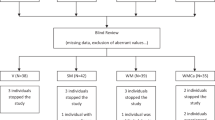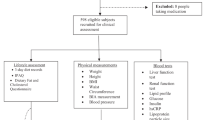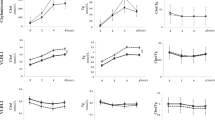Abstract
Objective: To investigate the effect of moderate changes in dietary fatty acid profile on postprandial risk factors for cardiovascular disease (CVD).
Design: Double-blind, randomised, crossover, intervention trial.
Setting: University of Auckland Human Nutrition Unit, New Zealand.
Subjects: A total of 18 lean healthy men.
Interventions: A dairy butter fat modified to reduce the saturated:unsaturated fatty acid ratio and a conventional high saturated butter fat were given on two separate occasions as a high-fat test meal (59±4 g fat; 71 en% fat) at breakfast. A fat exclusion lunch, dinner and snacks were also given. Blood samples were collected at 0 (baseline), 1, 3, 6, 10 and 24 h.
Results: Maximum peak in total triacylglycerol (TAG) occurred 3 h postprandially and was highest on modified treatment (diet, P<0.05) due predominantly to increased TAG within the chylomicron-rich fraction. Transient peaks in total-, LDL- and HDL-cholesterol occurred postprandially, but did not differ between dietary treatments (P>0.05). There were no differential effects of diet on postprandial free fatty acids, apo A, apo B, glucose, insulin, amylin or haemostatic clotting factors (P>0.05).
Conclusions: In a group of healthy young men, replacement of 16% of total saturated fatty acids by mono- and polyunsaturated fats within a dairy lipid did not induce postprandial changes in CVD risk that may be considered beneficial for health.
Sponsorship: Fonterra, Wellington; New Zealand.
This is a preview of subscription content, access via your institution
Access options
Subscribe to this journal
Receive 12 print issues and online access
$259.00 per year
only $21.58 per issue
Buy this article
- Purchase on Springer Link
- Instant access to full article PDF
Prices may be subject to local taxes which are calculated during checkout




Similar content being viewed by others
References
Apgar J, Shively C & Tarka S (1987): Digestibility of cocoa butter and corn oil and their influence on fatty acid distribution in rats. J. Nutr. 117, 660–665.
Avarim M, Fuhrman B & Brook JG (1986): Postprandial plasma lipoproteins in normal and hypertriglyceridaemic subjects and their in vitro effect on platelet activity: differences between saturated and polyunsaturated fats. Scand. J. Clin. Lab. Invest. 46, 571–579.
Bergeron N & Havel RJ (1997): Assessment of postprandial lipaemia: nutritional influences. Curr. Opin. in Lipidol. 8, 43–52.
Berglund L (2002): Postprandial lipemia and obesity — any unique features? Am. J. Clin. Nutr. 76, 299–300.
Cohen JC, Noakes TD & Benade AJS (1988): Serum triglyceride responses to fatty meals: effects of meal fat content. Am. J. Clin. Nutr. 47, 825–827.
Cortner JA, Coates PM, Le NA, Cryer DR, Ragni MC, Faulkner A & Langer T (1987): Kinetics of chylomicron remnant clearance in normal and hyperproteinemic subjects. J. Lipid Res. 28, 195–206.
Daumerie CM, Woollett LA & Dietschy JM (1992): Fatty acids regulate hepatic low density lipoprotein receptor activity through redistribution of intra-cellular cholesterol pools. Proc. Nat. Acad. Sc. USA 89, 10797–10801.
de Graaf J, Hendriks JC, Demacker PN & Stalenhoef AF (1993): Identification of multiple dense LDL subfractions with enhanced susceptibilty to in vitro oxidation among hypertriglyceridemic subjects: normalization after clofibrate treatment. Arteriosclerosis Thrombosis 13, 712–719.
de Bruin T, Brouwer C, Gimpel J & Erkelens D (1991): Postprandial decrease in HDL cholesterol and HDL apoA-I in normal subjects in relation to triglyceride metabolism. Am. J. Physiol. 260, E492–E498.
Dubois C, Armand M, Azais-Braesco V, Portugal H, Pauli A-M, Bernard P-M, Latge C, Lafont H, Borel P & Lairon D (1994): Effects of moderate amounts of emulsified dietary fat on postprandial lipemia and lipoproteins in normolipidemic adults. Am. J. Clin. Nutr. 60, 374–382.
Edelin Y, kinsell L, Michaels G & Splitter S (1968): Relations between dietary fat and fatty acid composition of endogenous and exogenous very low density lipoprotein triglyceride. Metabolism 17, 544–554.
Freese R & Mutanen M (1995): Postprandial changes in platelet function and coagulation factors after high-fat meals with different fatty acid compositions. Eur. J. Clin. Nutr. 49, 658–664.
Gordon T, Castelli WP, Hjortland MC, Kannel WB & Dawber TR (1977): High density lipoprotein as a protective factor against heart disease. The Framingham Study. Am. J. Med. 62, 707–714.
Groot PHE & Scheek LM (1984): Effects of fat ingestion on high density lipoprotein profiles in human sera. J. Lipid Res. 25, 684–692.
Groot PHE, van Stiphout WAHJ, Krauss XH, Jansen H, van Tol A, van Ramshorst E, Chin-On S, Hofman A, Cresswell SR & Havekes L (1991): Postprandial lipoprotein metabolism in normolipidemic men with and without coronary artery disease. Arteriosclerosis Thrombosis 11, 653–662.
Grundy SM (1986): Comparison of monounsaturated fatty acids and carbohydrates for lowering plasma cholesterol. N. Eng. J. Med. 314, 745–748.
Harris W, Connor W, Illingworth R, Rothrock D & Foster D (1990): Effects of fish oil on VLDL triglyceride kinetics in humans. J. Lipid Res. 31, 1549–1558.
Harris WS, Connor WE, Alam N & Illingworth DR (1988): Reduction of postprandial triglyceridemia in humans by dietary n-3 fatty acids. J. Lipid Res. 29, 1451–1460.
Havel RJ (1994): Triglyceride-rich lipoproteins and atherosclerosis — new perspectives. Am. J. Clin. Nutr. 59, 795–799.
Havel RJ (1997a): Milk fat consumption and human health: recent NIH and other American Governmental recommendations. In Milk Composition and Biotechnology, eds RAS Welch, DJW Burns, SR Davis, AI Popay & CG Prosser, pp 13–22. Wallingford, UK: CAB International.
Havel RJ (1997b): Postprandial lipid metabolism: an overview. Proc. Nutr. Soc. 56, 659–666.
Havel RJ, Kane JP & Kashyap ML (1973): Interchange of apolipoproteins between chylomicron and high density lipoproteins during alimentary lipaemia in man. J. Clin. Invest. 52, 32–38.
Hazzard WR & Bierman EL (1976): Delayed clearance of chylomicron remnants following vitamin-A-containing oral fat loads in broad-beta disease (type III hyperlipoprotein-emia). Metabolism 25, 777–801.
Higashi K, Ishikawa T & Shige H (1997): Olive oil increases the magnitude of postprandial chylomicron remnants compared to milk and safflower oil. J. Am. Coll. Nutr. 16, 429–434.
Hunter KA, Crosbie LC, Horgan GW, Miller GJ & Dutta-Roy AK (2001): Effect of diets rich in oleic acid, stearic acid and linoleic acid on postprandial haemostatic factors in healthy young men. Br. J. Nutr. 86, 207–215.
Karpe F (1999): Postprandial lipoprotein metabolism and atherosclerosis. J. Intern. Med. 246, 341–355.
Katan MB (1997): High-oil compared with low-fat, high-carbohydrate diets in the prevention of ischemic heart disease. Am. J. Clin. Nutr. 66 (Suppl), 974S–979S.
Larsen LF, Bladbjerg EM, Jespersen J & Marckmann P (1997): Effects of dietary fat quality and quantity on postprandial activation of blood caogulation factor VII. Ateriosclerosis, Thrombosis Vasc. Biol. 17, 2904–2909.
Larsen LF, Jespersen J & Marckmann P (1999): Are olive oil diets antithrombotic? Diets enriched with olive, rapeseed, or sunflower oil affect postprandial factor VII differently. Am. J. Clin. Nutr. 70, 976–982.
Larsen LF, Marckmann P, Bladbjerg EM, Ostergaard PB, Sidelmann J & Jespersen J (2000): The link between high-fat meals and postprandial activation of blood coagulation factor VII possibly involves kallikrein. Scand. J. Clin. Lab. Investig. 60, 45–54.
Mata P, Alvarez-Sala LA, Rubio MJ, Nuno J & De Oya M (1992): Effects of long-term monounsaturated- vs polyunsaturated-enriched diets on lipoproteins in healthy men and women. Am. J. Clin. Nutr. 55, 846–850.
Mekki N, Charbonnier M, Borel P, Leonardi J, Juhel C, Portugal H & Lairon D (2002): Butter differs from olive oil and sunflower oil in its effects on postprandial lipemia and triacylglycerol-rich lipoproteins after single mixed meals in healthy young men. J. Nutr. 132, 3642–3649.
Mensink RP & Katan MB (1989): Effect of a diet enriched with monounsaturated or polyunsaturated fatty acids on levels of low-desity and high-density lipoprotein cholesterol in healthy women and men. N. Engl. J. Med. 321, 436–441.
Miesenbock G & Patsch JR (1992): Postprandial hyperlipidaemia: the search for the atherogenic lipoprotein. Curr. Opin. Lipidol. 3, 196–201.
Miller GJ (1989): Postprandial lipaemia and haemostatic factors. Atherosclerosis 141 (Suppl), S47–S51.
Miller GJ (1998): Effects of diet composition on coagulation pathways. Am. J. Clin. Nutr. 67 (Suppl), 542S–545S.
Miller GJ, Martin JC, Mitropoulos KA, Reeves BE, Thompson RL, Meade TW, Cooper JA & Cruickshank JK (1991): Plasma factor VII is activated by postprandial triglyceridaemia, irrespective of dietary fat composition. Atherosclerosis 86, 163–171.
Muesing RA, Griffin P & Mitchell P (1995): Corn oil and beef tallow elicit different postprandial responses in triglycerides and cholesterol, but similar changes in constituents of high-density lipoprotein. J. Am. Coll. Nutr. 14, 53–60.
Oakley FR, Sanders TAB & Miller GJ (1998): Postprandial effects of an oleic acid-rich oil compared with butter on clotting factor VII and fibrinolysis in healthy men. Am. J. Clin. Nutr. 68, 1202–1207.
Parks EJ (2001): Recent findings in the study of postprandial lipemia. Curr. Atherosclerosis Rep 3, 462–470.
Patsch J R, Prasad S, Gotto AM Jr & Bengtsson-Olivecrona G (1984): A key for the conversion of high density lipoprotein2 into high density lipoprotein3 by hepatic lipase. J. Clin. Invest. 74, 2017–2023.
Patsch JR, Miesenbock G, Hopferwieser T, Muhlburger V, Knapp E, Dunn JK, Gotto AM Jr & Partsch W (1992): Relation of triglyceride metabolism and coronary artery disease. Studies in the postprandial state. Arteriosclerosis Thrombosis 12, 1336–1345.
Patsch W, Esterbauer H, Föger B & Patsch JR (2000): Postprandial lipemia and coronary risk. Curr. Atherosclerosis Rep. 2, 232–242.
Phan CT, Mortimer B-C, Martins IJ & Redgrave TG (1999): Plasma clearance of chylomicrons from butterfat is not dependent on saturation: studies with butterfat fractions and other fats containing triacylglycerols with low and high melting points. Am. J. Clin. Nutr. 69, 1151–1161.
Poppitt SD, Keogh GF, Mulvey TB, McArdle BA, MacGibbon A & Cooper GJ (2002): Lipid-lowering effects of a modified butter fat: a controlled intervention trial. Eur. J. Clin. Nutr. 56, 64–71.
Rifai N, Merrill JR & Holly RG (1990): Postprandial effect of a high fat meal on plasma lipid, lipoprotein cholesterol and apolipoprotein measurements. Ann. Clin. Biochem. 27, 489–493.
Roche HM & Gibney MJ (1997): Postprandial coagulation factor VII activity: effect of monounsaturated fatty acids. Br. J. Nutr. 77, 537–549.
Roche HM & Gibney MJ (2000): The effect of long-chain n-3 polyunsaturated fatty acids on fasting and postprandial triacylglycerol metabolism. Am. J. Nutr. 71, 232S–237S.
Roche HM, Zampelas A, Jackson KG, Williams CM & Gibney MJ (1998): The effect of test meal monounsaturated fatty acid: saturated fatty acid ratio on postprandial lipid metabolism. Br. J. Nutr. 79, 419–424.
Salomaa V, Rasi V, Pekkanen J, Jauhiainen M, Vahtera E, Pietinen P, Korhonen M, Kuulasmaa K & Ehnholm C (1993): The effects of saturated fat and n-6 polyunsaturated fat on postprandial lipaemia and hemostatic activity. Atherosclerosis 103, 1–11.
Sanders TAB, Oakley FR, Cooper JA & Miller GJ (2001): Influence of a stearic acid-rich structured triacylglycerol on postprandial lipemia, factor VII concentrations, and fibrinolytic activity in healthy subjects. Am. J. Clin. Nutr. 73, 715–721.
Sattar N, Petrie JR & Jaap AJ (1998): The atherogenic lipoprotein phenotype and vascular endothelial dysfunction. Atherosclerosis 138, 229–235.
Schlierf G, Oster P, Raetzer H, Schellenberg B, Heuck CC, Edlich S, Schilling I & Willenberg A (1977): Acute dietary effects on diurnal plasma lipids in normal subjects. Atherosclerosis 26, 525–533.
Schrijver R, Vermeulen D & Viaene E (1991): Lipid metabolism responses in rats fed beef tallow, native or randomised fish oil and native or randomised peanut oil. J. Nutr. 121, 948–955.
Shimizu S, Tani Y, Yamada H, Tabata M & Murachi T (1980): Enzymatic determination of serum-free fatty acids: a colorimetric method. Analyt. Biochem. 107, 193–198.
Tall A, Blum C, Forester G & Nelson C (1982): Changes in the distribution and contribution of plasma high density lipoproteins after ingestion of fat. J. Biol. Chem. 257, 198–207.
Tholstrup T, Sandstrom B, Hermansen JE & Holmer G (1998): Effect of modified dairy fat on postprandial and fasting plasma lipids and lipoproteins in healthy young men. Lipids 33, 11–21.
Thomsen C, Rasmussen O, Lousen T, Holst JJ, Fenselau S, Schrezenmeir J & Hermansen K (1999): Differential effects of saturated and monounsaturated fatty acids on post-prandial lipemia and incretin responses in healthy subjects. Am. J. Clin. Nutr. 69, 1135–1143.
Weintraub MS, Zechner R, Brown A, Eisenberg S & Breslow JL (1988): Dietary polyunsaturated fats of the ω-6 and ω-3 series reduce postprandial lipoprotein levels. J. Clin. Invest. 82, 1884–1893.
Willett WC (1998): Is dietary fat a major determinant of body fat? Am. J. Clin. Nutr. 67 (Suppl), 556S–562S.
Zampelas A, Murphy L, Morgan LM & Williams CM (1994): Postprandial lipoprotein lipase, insulin and gastric inhibitory polypeptide responses to test meals of different fatty acid composition: comparison of saturated, n-6 and n-3 polyunsaturated fatty acids. Eur. J. Clin. Nutr. 48, 849–858.
Zilversmit DB (1979): Atherogenesis: a postprandial phenomenon. Circulation 60, 473–485.
Acknowledgements
We thank Glyn Muir who ran the metabolic kitchen during this trial. We are also grateful to Jenneke van Drunen, Esther de Swart and Joanna Lawrence for their considerable assistance during studentships. Cynthia Tse provided laboratory and administrative support throughout. We also thank the subjects who participated in this trial.
Author information
Authors and Affiliations
Contributions
Guarantor: SD Poppitt.
Corresponding author
Rights and permissions
About this article
Cite this article
Poppitt, S., Keogh, G., Mulvey, T. et al. Effect of moderate changes in dietary fatty acid profile on postprandial lipaemia, haemostatic and related CVD risk factors in healthy men. Eur J Clin Nutr 58, 819–827 (2004). https://doi.org/10.1038/sj.ejcn.1601882
Received:
Revised:
Accepted:
Published:
Issue Date:
DOI: https://doi.org/10.1038/sj.ejcn.1601882
Keywords
This article is cited by
-
Extra virgin olive oil: More than a healthy fat
European Journal of Clinical Nutrition (2019)
-
Assessment of the Validity and Reproducibility of a Novel Standardized Test Meal for the Study of Postprandial Triacylglycerol Concentrations
Lipids (2017)
-
The Acute Effects of Postprandial Hypertriglyceridemia on Coagulation Parameters in Normal and Overweight Individuals
Indian Journal of Clinical Biochemistry (2015)
-
Postprandial effect of dietary fat quantity and quality on arterial stiffness and wave reflection: a randomised controlled trial
Nutrition Journal (2013)
-
No evidence of differential effects of SFA, MUFA or PUFA on post-ingestive satiety and energy intake: a randomised trial of fatty acid saturation
Nutrition Journal (2010)



